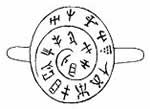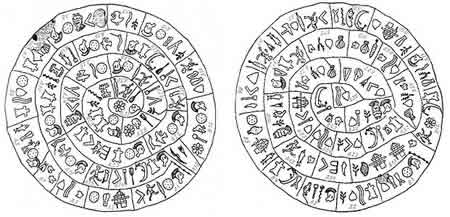-
Together with chronological cycle Tzolkin in the calendar of Maya there was
time circulation of Haab which consisted of 18 uinals or 20-day periods, that in
the sum is equal to duration of solar year. Namely 18x20=360 plus additional
5-day period and as a result there is annual cycle which have duration of 365
days. In total days or kins in the calendar of Maya correspond with 13
oshlahuntiku and 18 uinals of Tzolkin and Haab, also correspond with 20 tonals, that made
the basis of complex cyclic chronological
system.
Eighteen uinals in the cycle of Haab have been designated by graphical signs or
pictograms, that is shown in
figure.
 |
Figure shows eighteen uinals in the cycle of Haab which correspond to 360 days of solar year or otherwise to tell calendar circulation of the sun, and separately one pictogram of additional 5-day period which has the name Wayeb in the complex cyclic calendar of civilization Maya. |
-
Thirteen uinals in Tzolkin chronological cycle correspond with vowel letters
of Russian alphabet and gods of Vedic mythology in the category of Rudras, that
is described on previous page in this section of website. And eighteen uinals in
the calendar cycle of Haab can be correlated with nine numbers of decimal scale
of mathematical notation and numerology, and also with mythological gods of
Ancient Greece and graphical symbols of Tai Hsuan Ching in the Chinese Canon of
Supreme Mystery, that is shown below on this page.
Ratio of uinals of the calendar cycle Haab with dates of contemporary Gregorian
calendar are not certain, namely researchers of Mayan culture specify different
variants, some of which are shown below.
| Pop 3
April - 22 April. Wo 23 April - 12 May. Sip 13 May - 1 June. Sotz 2 June - 21 June. Sek 22 June - 11 July. Xul 12 July - 31 July. Yaxkin 1 August - 20 August. Mol 21 August - 9 September. Chen 10 September - 29 September. Yax 30 September - 19 October. Sac 20 October - 8 November. Keh 9 November - 28 November. Mak 29 November - 18 December. Kankin 19 December - 7 January. Muwan 8 January - 27 January. Pax 28 January - 16 February. Kayab 17 February - 8 March. Kumku 9 March - 28 March. Wayeb 29 March - 2 April. |
Pop
16 July - 4 August. Wo 5 August - 24 August. Sip 25 August - 13 September. Sotz 14 September - 3 October. Sek 4 October - 23 October. Xul 24 October - 12 November. Yaxkin 13 November - 2 December. Mol 3 December -22 December. Chen 23 December - 11 January. Yax 12 January - 31 January. Sac 1 February - 20 February. Keh 21 February - 12 March. Mak 13 March - 1 April. Kankin 2 April - 21 April. Muwan 22 April - 11 May. Pax 12 May - 31 May. Kayab 1 June - 20 June. Kumku 21 June - 10 July. |
Yaxkin 23 December - 11 January. Mol 12 January - 31 January. Chen 1 February - 20 February. Yax 21 February - 12 March. Sac 13 March - 1 April. Keh 2 April - 21 April. Mak 22 April - 11 May. Kankin 12 May - 31 May. Muwan 1 June - 20 June. Pax 21 June - 10 July. Kayab 11 July - 30 July. Kumku 31 July - 19 August. Pop 20 August - 8 September. Wo 9 September - 28 September. Sip 29 September - 18 October. Sotz 19 October - 7 November. Sek 8 November - 27 November. Xul 28 November - 17 December. |
-
Uinal with name Sek begins on June 22nd in the first list at the left, that
corresponds with a day of summer solstice. Uinals with names Chen and Yaxkin
begin on December 23rd in the second and third lists, that corresponds with a
day of winter solstice, and consequently it is possible to correlate the cycle
Haab to movement or calendar circulation of the sun. But exact beginning of Haab
is unknown, and consequently it is impossible to specify concrete ratio with
nine numbers of decimal numerology, and also mythological gods of Ancient Greece
and symbols of Tai Hsuan Ching in the Chinese Supreme Mystery.
For example, if to consider that beginning of the calendar cycle Haab in ancient
calendar of Maya was on December 23rd on day of winter solstice and first uinal
had name Yaxkin then ratio is the following.
Number 1 - Ares - Yaxkin (Dec 23 - Jan 11) and Pax
(Jun 21 - Jul 10) - ![]() offence.
offence.
Number 2 - Artemis - Mol (Jan 12 - Jan 31) and Kayab
(Jul 11 - Jul 30) - ![]() disaster.
disaster.
Number 3 - Hermes - Chen (Feb 1 - Feb 20) and Kumku
(Jul 31 - Aug 19) - ![]() repentance.
repentance.
Number 4 - Hera - Yax (Feb 21 - Mar 12) and Pop (Aug 20 - Sep 8) -
![]() misfortune.
misfortune.
Number 5 - Athena - Sac (Mar 13 - Apr 1) and Wo (Sep 9 - Sep 28) -
![]() neutrality.
neutrality.
Number 6 - Zeus - Keh (Apr 2 - Apr 21) and Sip (Sep 29 - Oct 18) -
![]() well-being.
well-being.
Number 7 - Hephaestus - Mak (Apr 22 - May 11) and Sotz
(Oct 19 - Nov 7) - ![]() regret.
regret.
Number 8 - Apollo - Kankin (May 12 - May 31) and Sek
(Nov 8 - Nov 27) - ![]() augury.
augury.
Number 9 - Aphrodite - Muwan (Jun 1 - Jun 20) and Xul
(Nov 28 - Dec 17) - ![]() success.
success.
Look detail information about ratio of nine numbers of decimal numerology
with mythological gods of Ancient Greece and graphical symbols of Tai Hsuan
Ching in the
Chinese Canon of Supreme Mystery on pages of other website
www.numeralgame.64g.ru.
Or in books of researchers of Mayan culture it is possible to find information
that chronological cycle of Haab had the ending on July 3rd, and the beginning
accordingly was on July, that approximately corresponds with rising of Sirius or
Sothis above horizon in ancient Egypt and also beginning of year in the Egyptian
calendar.
Therefore it is possible to compare the Haab cycle of civilization Maya to
cyclic calendar system of ancient Egypt where solar year proceeded 365 days and
consisted of 72 five-day periods, namely 72 pentads and five additional days or
epagomens in the end of annual circle, that too corresponds to nine numbers of
classical decimal numerology.
Distinction of two chronological systems consists that 20-day periods or uinals
in the cyclic calendar of Maya correspond with nine numerological numbers, as
365-5=360/20=18/2=9. And five-day periods or pentads in the cyclic calendar of
ancient Egypt correspond with numerological numbers, as 365-5=360/5=72/8=9.
And also it is possible to compare uinals of the Haab cycle in calendar of
civilization Maya with 36 ancient Egyptian Decans, namely with 36 segments of
celestial star sky or constellations in the context of astrology of ancient
Egypt. Because celestial star circle of the sky has size of 360 degrees, and
each Decan of 360/36=10 degrees, and as a result each 20-day period or uinal in
the calendar cycle of Haab can be correlated with two Decans.
Look information on the cyclic calendar of ancient Egypt, and also on 36
Decans or star constellations of the sky on pages of website:
www.numeralgame.64g.ru/en.htm.
Similar calendar and numerological sign system can be seen on the Ring from
Mavro Spelaio which is shown in figure.
 |
The ring from Mavro Spelaio is archeological artifact
or ancient gold ring on which 19 pictograms are represented, that is
comparable to eighteen 20-day and one five-day period within 365 days of
the calendar cycle of Haab, and also it is comparable to nine numbers of
classical decimal numerology. Pictograms on the ring from Mavro Spelaio are letters or graphical signs of Minoan writing or Scripts of Mycenaean Crete. And consequently pictograms can mean any words, but also can be calendar designations which form geometrical spiral which is comparable with circular numerological matrix which has two circles and nine numerical axes. Or it is possible to assume that pictograms on the Ring from Mavro Spelaio are letters which are similar to runic inscriptions and mean a magic spell or conjuration which is constructed according to numerological principles, namely according to rules which connect written signs with numbers and calendar dates. |
And also pictograms of well-known Phaistos Disc can be considered as calendar and numerological sign system which is similar to the cycle of Haab in calendar of Maya, that is shown in following figure.
 |
The Phaistos Disc is archeological artifact or a round
plate which has images of pictograms on both sides. Each side has
external circle which is divided into 12 fields or zones, that is
comparable to twelve signs of zodiac. And also each side has internal
spiral which is divided into 18 or 19 fields, that is comparable to
quantity of pictograms or letters on the Ring from Mavro Spelaio. Namely each field of Phaistos Disc unites some graphical images or pictograms, that differs from symbols of the Ring from Mavro Spelaio, but however quantity of fields allows to compare sign systems of two archeological artifacts. |
In essence pictograms on twelve external fields of Phaistos Disc can be correlated to zodiacal constellations. And pictograms of internal fields can be correlated with eighteen 20-day and one five-day period within 365 days in the annual cycle of Haab in calendar system of Maya, and also with 36 segments of celestial star sky or constellations of Decans in the context of astrology of ancient Egypt. Or with names of gods in the Greek myths and symbols Tai Hsuan Ching of the Chinese Book of Great Secret or Canon of Supreme Mystery. Because all listed sign systems of ancient civilizations are comparable to nine numbers of decimal scale of mathematical notation and classical decimal numerology.
Following page shows ratio of letters in the Greek
alphabet with circular matrix of numbers of decimal numerology and names
of mythological gods of Ancient Greece.
Also following page speaks about the Golden Fleece which can be runic alphabetic
system of ancient civilizations.
And also set of pages in this section of website contains information about ancient Phoenician characters and contemporary Hebrew alphabet, scale of mathematical notation and metaphysical supernatural reality, esoteric codes of words in languages and pictographic designations of days, manuscripts or library of Dead Sea and runic signs of Greek alphabet.